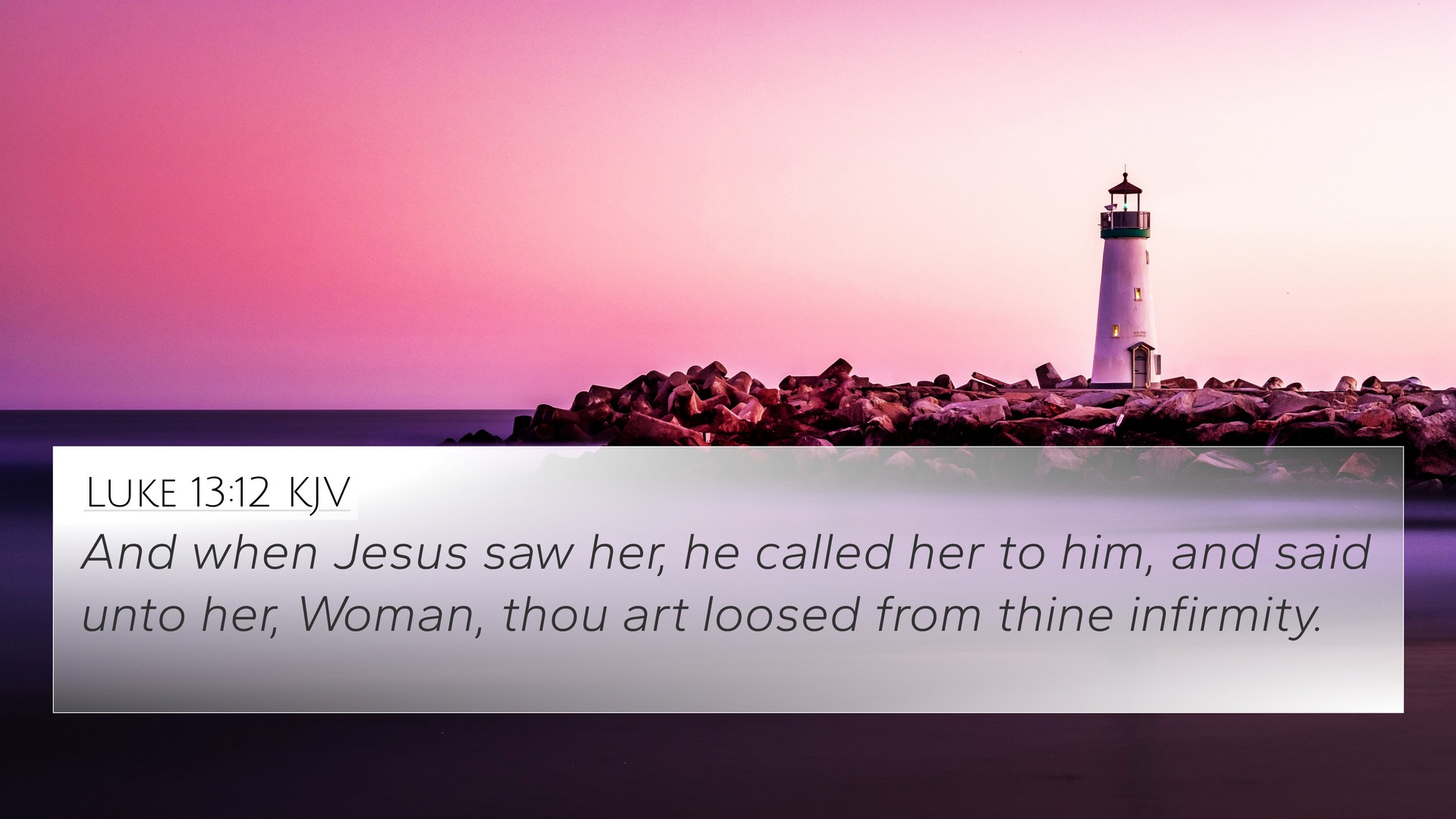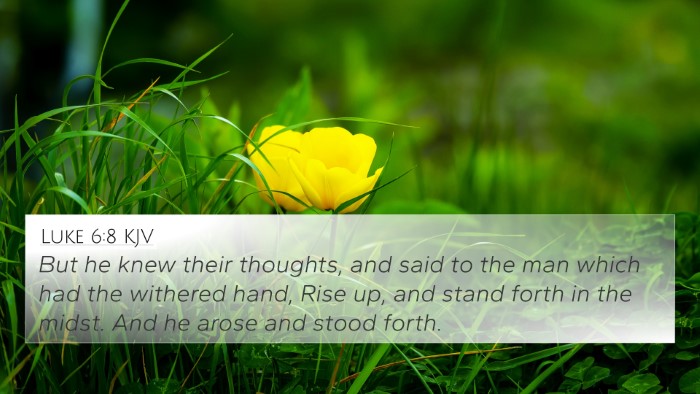Understanding Luke 13:12
Luke 13:12 states, "When Jesus saw her, he called her forward and said to her, 'Woman, you are set free from your infirmity.'
Contextual Analysis
This verse occurs in the context of Jesus performing healing on the Sabbath, which is a significant theme throughout the Gospels. It reflects Jesus’ compassion and authority over physical afflictions and his challenge to the religious norms of the time.
Insights from Public Domain Commentaries
Matthew Henry's Commentary
Matthew Henry emphasizes the power of Christ's authority in this moment, noting that the act of calling the woman forward signifies not just a physical healing but an invitation to partake in spiritual freedom. Henry suggests that the phrase “you are set free from your infirmity” embodies both a physical and spiritual liberation, highlighting Jesus's role as a healer of both body and soul.
Albert Barnes' Notes
Albert Barnes elaborates on the significance of the woman being called forward by Jesus. He points out that her infirmity for eighteen years symbolizes a prolonged suffering that many experience in their spiritual lives. By freeing her, Jesus illustrates the core mission of His ministry—to bring healing and restoration. Barnes emphasizes the importance of recognizing Jesus' authority over sickness and suffering, reinforcing the theme that genuine faith leads to freedom.
Adam Clarke's Commentary
Adam Clarke provides a thorough examination of the social implications of this miracle. He notes that the woman, bowing down for so long, represents those who are oppressed under the weight of sin or societal pressure. Clarke discusses the interpretation of the word "infirmity," suggesting that while it carries physical connotations, it also resonates with spiritual bondage. The act of healing signifies Jesus' breaking down of barriers and His desire for holistic well-being among believers.
Bible Verse Cross-References
- Isaiah 61:1 - "The Spirit of the Sovereign Lord is on me, because the Lord has anointed me to proclaim good news to the poor. He has sent me to bind up the brokenhearted, to proclaim freedom for the captives and release from darkness for the prisoners." - This verse connects with the theme of healing and liberation.
- Matthew 8:17 - "This was to fulfill what was spoken through the prophet Isaiah: 'He took up our infirmities and bore our diseases.'" - This draws parallels with Jesus' healing ministry.
- John 8:36 - "So if the Son sets you free, you will be free indeed." - This verse emphasizes freedom found in Christ.
- Acts 10:38 - "How God anointed Jesus of Nazareth with the Holy Spirit and power, and how he went around doing good and healing all who were under the power of the devil, because God was with him." - This supports the understanding of Jesus' mission and authority.
- Luke 4:18 - "The Spirit of the Lord is on me, because he has anointed me to proclaim good news to the poor. He has sent me to proclaim freedom for the prisoners and recovery of sight for the blind, to set the oppressed free." - A direct thematic link to Jesus’ healing ministry.
- Mark 5:34 - "He said to her, 'Daughter, your faith has healed you. Go in peace and be freed from your suffering.'" - A reminder of the connection between faith and healing.
- Galatians 5:1 - "It is for freedom that Christ has set us free. Stand firm, then, and do not let yourselves be burdened again by a yoke of slavery." - This underlines the spiritual aspect of the freedom proclaimed in Luke 13:12.
Thematic Connections
The healing of the woman in Luke 13:12 can be viewed as part of a larger narrative concerning:
- **The compassion of Christ toward the marginalized and suffering**
- **The confrontation between Christ and established religious traditions**
- **The holistic nature of Jesus' healing ministry, addressing both physical and spiritual needs**
Cross-Referencing Biblical Texts
This verse allows for a deeper exploration of several thematic patterns within scripture:
- Healing and Restoration: An overarching biblical theme evident from the Old Testament through the New Testament, where God is portrayed as a healer (e.g., Exodus 15:26).
- Faith and Works: How faith in Christ leads to healing and freedom, explored through various narratives of Jesus’ miracles.
- Sabbath Observance: The implications of healing on the Sabbath can lead to discussions about the spirit versus the letter of the law.
Understanding the Role of Cross-Referencing in Biblical Study
Cross-referencing Bible verses is a powerful method of deepening one's understanding of scripture. It allows readers to:
- Identify connections between biblical texts that enhance thematic understanding.
- Draw parallels across different parts of the Bible, helping to reveal the cohesive narrative of salvation.
- Utilize tools such as a Bible concordance or cross-reference Bible study guides to locate specific verses and their connections easily.
Conclusion
Luke 13:12 serves as a profound reminder of Jesus' mission to heal and restore not only physically but also spiritually. The rich insights provided by various commentaries highlight the depth of this verse while establishing it firmly in the wider context of biblical themes of freedom and healing.
Further Study Suggestions
To build a richer understanding, consider exploring:
- How to identify cross-references in the Bible effectively.
- Detailed studies on how the New Testament fulfills Old Testament prophecies about healing.
- Comparative analyses between various Gospel accounts of healing miracles.








